mirror of
https://github.com/LCTT/TranslateProject.git
synced 2025-02-28 01:01:09 +08:00
118 lines
6.7 KiB
Markdown
118 lines
6.7 KiB
Markdown
|
|
Getting started with Anaconda Python for data science
|
||
|
|
======
|
||
|
|
|
||
|
|

|
||
|
|
Like many others, I've been trying to get involved in the rapidly expanding field of data science. When I took Udemy courses on the [R][1] and [Python][2] programming languages, I downloaded and installed the applications independently. As I was trying to work through the challenges of installing data science packages like [NumPy][3] and [Matplotlib][4] and solving the various dependencies, I learned about the [Anaconda Python distribution][5].
|
||
|
|
|
||
|
|
Anaconda is a complete, [open source][6] data science package with a community of over 6 million users. It is easy to [download][7] and install, and it is supported on Linux, MacOS, and Windows.
|
||
|
|
|
||
|
|
I appreciate that Anaconda eases the frustration of getting started for new users. The distribution comes with more than 1,000 data packages as well as the [Conda][8] package and virtual environment manager, so it eliminates the need to learn to install each library independently. As Anaconda's website says, "The Python and R conda packages in the Anaconda Repository are curated and compiled in our secure environment so you get optimized binaries that 'just work' on your system."
|
||
|
|
|
||
|
|
I recommend using [Anaconda Navigator][9], a desktop graphical user interface (GUI) system that includes links to all the applications included with the distribution including [RStudio][10], [iPython][11], [Jupyter Notebook][12], [JupyterLab][13], [Spyder][14], [Glue][15], and [Orange][16]. The default environment is Python 3.6, but you can also easily install Python 3.5, Python 2.7, or R. The [documentation][9] is incredibly detailed and there is an excellent community of users for additional support.
|
||
|
|
|
||
|
|
### Installing Anaconda
|
||
|
|
|
||
|
|
To install Anaconda on my Linux laptop (an I3 with 4GB of RAM), I downloaded the Anaconda 5.1 Linux installer and ran `md5sum` to verify the file:
|
||
|
|
```
|
||
|
|
$ md5sum Anaconda3-5.1.0-Linux-x86_64.sh
|
||
|
|
|
||
|
|
```
|
||
|
|
|
||
|
|
Then I followed the directions in the [documentation][17], which instructed me to issue the following Bash command whether I was in the Bash shell or not:
|
||
|
|
```
|
||
|
|
$ bash Anaconda3-5.1.0-Linux-x86_64.sh
|
||
|
|
|
||
|
|
```
|
||
|
|
|
||
|
|
`/home/<user>/.bashrc`?" I allowed it and restarted the shell, which I found was necessary for the `.bashrc` environment to work correctly.
|
||
|
|
|
||
|
|
I followed the installation directions exactly, and the well-scripted install took about five minutes to complete. When the installation prompted: "Do you wish the installer to prepend the Anaconda install location to PATH in your?" I allowed it and restarted the shell, which I found was necessary for theenvironment to work correctly.
|
||
|
|
|
||
|
|
After completing the install, I launched Anaconda Navigator by entering the following at the command prompt in the shell:
|
||
|
|
```
|
||
|
|
$ anaconda-navigator
|
||
|
|
|
||
|
|
```
|
||
|
|
|
||
|
|
Every time Anaconda Navigator launches, it checks to see if new software is available and prompts you to update if necessary.
|
||
|
|
|
||
|
|
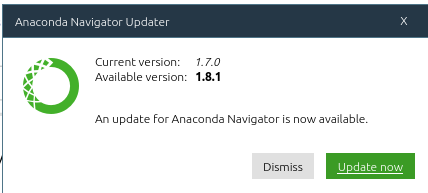
|
||
|
|
|
||
|
|
Anaconda updated successfully without needing to return to the command line. Anaconda's initial launch was a little slow; that plus the update meant it took a few additional minutes to get started.
|
||
|
|
|
||
|
|
You can also update manually by entering the following:
|
||
|
|
```
|
||
|
|
$ conda update anaconda-navigator
|
||
|
|
|
||
|
|
```
|
||
|
|
|
||
|
|
### Exploring and installing applications
|
||
|
|
|
||
|
|
Once Navigator launched, I was free to explore the range of applications included with Anaconda Distribution. According to the documentation, the 64-bit Python 3.6 version of Anaconda [supports 499 packages][18]. The first application I explored was [Jupyter QtConsole][19]. The easy-to-use GUI supports inline figures and syntax highlighting.
|
||
|
|
|
||
|
|
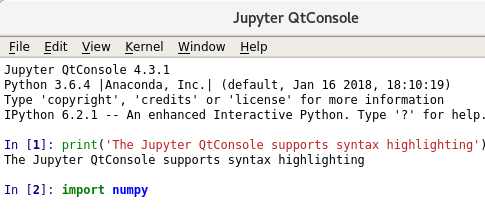
|
||
|
|
|
||
|
|
Jupyter Notebook is included with the distribution, so (unlike other Python environments I have used) there is no need for a separate install.
|
||
|
|
|
||
|
|
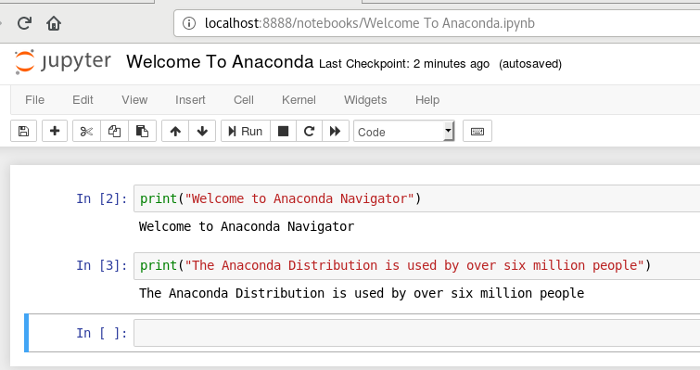
|
||
|
|
|
||
|
|
I was already familiar with RStudio. It's not installed by default, but it's easy to add with the click of a mouse. Other applications, including JupyterLab, Orange, Glue, and Spyder, can be launched or installed with just a mouse click.
|
||
|
|
|
||
|
|
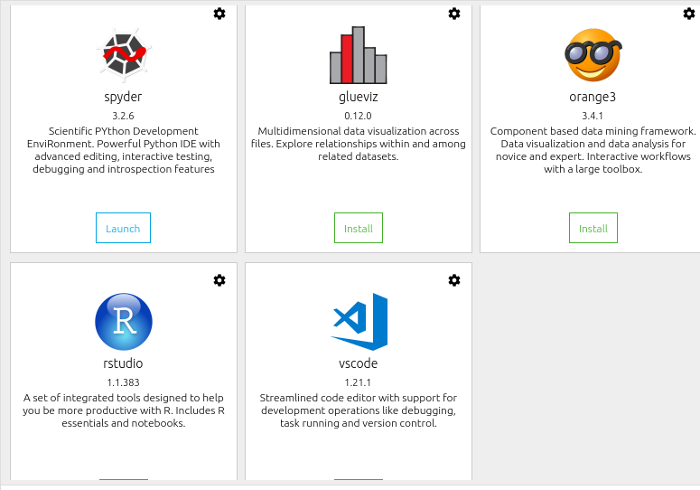
|
||
|
|
|
||
|
|
One of the Anaconda distribution's strengths is the ability to create multiple environments. For example, if I wanted to create a Python 2.7 environment instead of the default Python 3.6, I would enter the following in the shell:
|
||
|
|
```
|
||
|
|
$ conda create -n py27 python=2.7 anaconda
|
||
|
|
|
||
|
|
```
|
||
|
|
|
||
|
|
Conda takes care of the entire install; to launch it, just open the shell and enter:
|
||
|
|
```
|
||
|
|
$ anaconda-navigator
|
||
|
|
|
||
|
|
```
|
||
|
|
|
||
|
|
Select the **py27** environment from the "Applications on" drop-down in the Anaconda GUI.
|
||
|
|
|
||
|
|
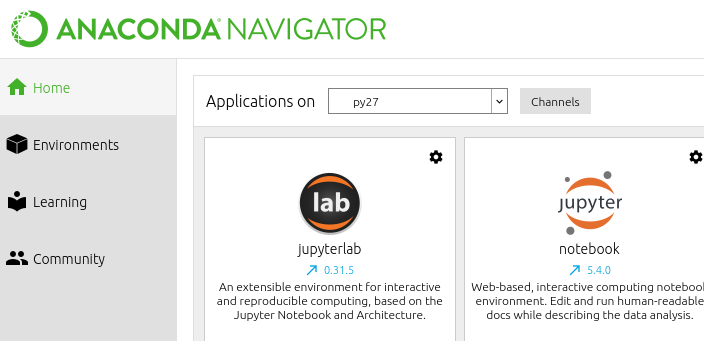
|
||
|
|
|
||
|
|
### Learn more
|
||
|
|
|
||
|
|
There's a wealth of information available about Anaconda if you'd like to know more. You can start by searching the [Anaconda Community][20] and its [mailing list][21].
|
||
|
|
|
||
|
|
Are you using Anaconda Distribution and Navigator? Let us know your impressions in the comments.
|
||
|
|
|
||
|
|
--------------------------------------------------------------------------------
|
||
|
|
|
||
|
|
via: https://opensource.com/article/18/4/getting-started-anaconda-python
|
||
|
|
|
||
|
|
作者:[Don Watkins][a]
|
||
|
|
选题:[lujun9972](https://github.com/lujun9972)
|
||
|
|
译者:[译者ID](https://github.com/译者ID)
|
||
|
|
校对:[校对者ID](https://github.com/校对者ID)
|
||
|
|
|
||
|
|
本文由 [LCTT](https://github.com/LCTT/TranslateProject) 原创编译,[Linux中国](https://linux.cn/) 荣誉推出
|
||
|
|
|
||
|
|
[a]:https://opensource.com/users/don-watkins
|
||
|
|
[1]:https://www.r-project.org/
|
||
|
|
[2]:https://www.python.org/
|
||
|
|
[3]:http://www.numpy.org/
|
||
|
|
[4]:https://matplotlib.org/
|
||
|
|
[5]:https://www.anaconda.com/distribution/
|
||
|
|
[6]:https://docs.anaconda.com/anaconda/eula
|
||
|
|
[7]:https://www.anaconda.com/download/#linux
|
||
|
|
[8]:https://conda.io/
|
||
|
|
[9]:https://docs.anaconda.com/anaconda/navigator/
|
||
|
|
[10]:https://www.rstudio.com/
|
||
|
|
[11]:https://ipython.org/
|
||
|
|
[12]:http://jupyter.org/
|
||
|
|
[13]:https://blog.jupyter.org/jupyterlab-is-ready-for-users-5a6f039b8906
|
||
|
|
[14]:https://spyder-ide.github.io/
|
||
|
|
[15]:http://glueviz.org/
|
||
|
|
[16]:https://orange.biolab.si/
|
||
|
|
[17]:https://docs.anaconda.com/anaconda/install/linux
|
||
|
|
[18]:https://docs.anaconda.com/anaconda/packages/py3.6_linux-64
|
||
|
|
[19]:http://qtconsole.readthedocs.io/en/stable/
|
||
|
|
[20]:https://www.anaconda.com/community/
|
||
|
|
[21]:https://groups.google.com/a/continuum.io/forum/#!forum/anaconda
|